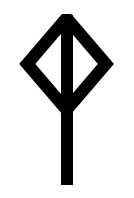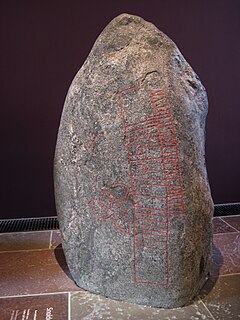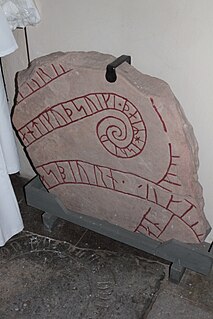Runes

It is practically impossible to render the runes in all the various ways that they appear in the inscriptions, and so the way they look has to be presented in pictures and in drawings. [2]
Runic transliteration and transcription are part of analysing a runic inscription which involves transliteration of the runes into Latin letters, transcription into a normalized spelling in the language of the inscription, and translation of the inscription into a modern language. There is a long-standing practice of formatting transliterations in boldface and transcriptions in Italic type , as the two forms of rendering a runic text have to be kept distinct. [1]
By not only showing the original inscription, but also transliterating, transcribing and translating, scholars present the analysis in a way that allows the reader to follow their interpretation of the runes. Every step has its challenges, but most Younger Futhark inscriptions are quite easy to interpret. Most Scandinavians can learn to read runic inscriptions with a little training. The Elder Futhark inscriptions, however, are much more challenging and they demand a great deal of knowledge in historical linguistics. Standard works such as Sveriges runinskrifter contain extensive presentations of the ways inscriptions have been interpreted throughout the centuries. [2]

It is practically impossible to render the runes in all the various ways that they appear in the inscriptions, and so the way they look has to be presented in pictures and in drawings. [2]


Transliteration means that the runes are represented by a corresponding Latin letter in bold. No consideration is given to the sound the rune represented in the actual inscription, and a good example of this is the ansuz rune, which could vary greatly in shape. In the oldest Younger Futhark inscriptions, it always represented a nasal a, as in French an, but later it came to represent other phonemes such as /o/. However, some runemasters continued to use the ansuz rune for an a phoneme. The ansuz rune is always transliterated as o from the Younger Futhark, and consequently, the transliteration mon represents Old Norse man in a runestone from Bällsta, and hon represents Old Norse han in the Frösö Runestone, while forþom represents Old Norse forðom in an inscription from Replösa. [2]
Sometimes the runes are "dotted" which means that a dot has been added, and in transliterations dotted runes are treated differently from ordinary runes. Dotted u, k and i are transliterated as y, g and e though they are rather variations of the non-dotted runes than runes in their own right. [2]
Bind runes are marked with an arch. Some bind runes look in a way that makes it impossible to know which rune preceded the other, and then the scholar has to test the various combinations that give a comprehensible word. Thus all transliterations of bind runes are scholarly interpretations. [2]
Runes that are known from older depictions but that have since disappeared are rendered within square brackets. [2]
The runes are transcribed into normalized spellings of the languages the runes were written in, and normalizations are rendered with italics. Since a single rune may represent several different phonemes, normalizations can differ greatly from transliterations. The þ rune can represent both the Old Norse letter ð (as in English the) or þ (as in English thing). [2]
The orthography of the Old Norse language was diverse, being written in both Runic and Latin alphabets, with many spelling conventions, variant letterforms, and unique letters and signs. In modern times, scholars established a standardized spelling for the language. When Old Norse names are used in texts in other languages, modifications to this spelling are often made. In particular, the names of Old Norse mythological figures often have several different spellings.
The Younger Futhark, also called Scandinavian runes, is a runic alphabet and a reduced form of the Elder Futhark, with only 16 characters, in use from about the 9th century, after a "transitional period" during the 7th and 8th centuries. The reduction, somewhat paradoxically, happened at the same time as phonetic changes that led to a greater number of different phonemes in the spoken language, when Proto-Norse evolved into Old Norse. Also, the writing custom avoided carving the same rune consecutively for the same sound, so the spoken distinction between long and short vowels was lost in writing. Thus, the language included distinct sounds and minimal pairs that were written the same.

The Elder Futhark, also known as the Older Futhark, Old Futhark, or Germanic Futhark, is the oldest form of the runic alphabets. It was a writing system used by Germanic peoples for Northwest Germanic dialects in the Migration Period. Inscriptions are found on artifacts including jewelry, amulets, plateware, tools, and weapons, as well as runestones in Scandinavia, from the 2nd to the 10th centuries.
Algiz is the name conventionally given to the "z-rune" ᛉ of the Elder Futhark runic alphabet. Its transliteration is z, understood as a phoneme of the Proto-Germanic language, the terminal *z continuing Proto-Indo-European terminal *s.

Runology is the study of the Runic alphabets, Runic inscriptions and their history. Runology forms a specialized branch of Germanic linguistics.
Jera is the conventional name of the j-rune ᛃ of the Elder Futhark, from a reconstructed Common Germanic stem *jēra- meaning "harvest, (good) year".
Ansuz is the conventional name given to the a-rune of the Elder Futhark, ᚨ. The name is based on Proto-Germanic *ansuz, denoting a deity belonging to the principal pantheon in Germanic paganism.

The Snoldelev Stone, listed as DR 248 in the Rundata catalog, is a 9th-century runestone that was originally located at Snoldelev, Ramsø, Denmark.

The sequence alu is found in numerous Elder Futhark runic inscriptions of Germanic Iron Age Scandinavia between the 3rd and the 8th century. The word usually appears either alone or as part of an apparent formula. The symbols represent the runes Ansuz, Laguz, and Uruz. The origin and meaning of the word are matters of dispute, though a general agreement exists among scholars that the word represents an instance of historical runic magic or is a metaphor for it. It is the most common of the early runic charm words.
The Greece runestones are about 30 runestones containing information related to voyages made by Norsemen to the Byzantine Empire. They were made during the Viking Age until about 1100 and were engraved in the Old Norse language with Scandinavian runes. All the stones have been found in modern-day Sweden, the majority in Uppland and Södermanland. Most were inscribed in memory of members of the Varangian Guard who never returned home, but a few inscriptions mention men who returned with wealth, and a boulder in Ed was engraved on the orders of a former officer of the Guard.
The Italy runestones are three or four Varangian runestones from 11th-century Sweden that tell of warriors who died in Langbarðaland, the Old Norse name for Italy. On these rune stones it is southern Italy that is referred to (Langobardia), but the Rundata project renders it rather anachronistically as Lombardy.
The England runestones are a group of about 30 runestones in Northern Europe which refer to Viking Age voyages to England. They constitute one of the largest groups of runestones that mention voyages to other countries, and they are comparable in number only to the approximately 30 Greece Runestones and the 26 Ingvar Runestones, of which the latter refer to a Viking expedition near the Caspian Sea. They were engraved in Old Norse with the Younger Futhark.

The Sigurd stones form a group of eight or nine Swedish runic inscriptions and one picture stone that depict imagery from the Germanic heroic legend of Sigurd the dragon slayer. They were made during the Viking Age and constitute the earliest Norse representations of the matter of the Völsung cycle that is the basis of the Middle High German Nibelungenlied and the Sigurd legends in the Poetic Edda, the Prose Edda, and the Völsunga saga.
The Viking runestones are runestones that mention Scandinavians who participated in Viking expeditions. This article treats the runestone that refer to people who took part in voyages abroad, in western Europe, and stones that mention men who were Viking warriors and/or died while travelling in the West. However, it is likely that all of them do not mention men who took part in pillaging. The inscriptions were all engraved in Old Norse with the Younger Futhark. The runestones are unevenly distributed in Scandinavia: Denmark has 250 runestones, Norway has 50 while Iceland has none. Sweden have as many as between 1,700 and 2,500 depending on definition. The Swedish district of Uppland has the highest concentration with as many as 1,196 inscriptions in stone, whereas Södermanland is second with 391.

Uppland Runic Inscription Fv1946;258 or U Fv1946;258 is the Rundata catalog designation for a Viking Age memorial runic inscription to two fathers that is located in Fällbro, which is about 5 kilometers northwest of Täby, Stockholm County, Sweden, which is in the historic province of Uppland.

Södermanland runic inscription 140 is a Viking Age runestone inscribed in Old Norse with the Younger Futhark runic alphabet. It and Sö 139 stand close together on the south side of the road next to the brook at Korpbro, between Lid and Aspa in Ludgo parish, Nyköping Municipality, in Södermanland, but Sö 140 was found broken and has been re-erected. A cross in the centre of the stone formed by five bind runes has been variously interpreted as an invocation of Thor or as part of the inscription.

The Nylarsker stone 2, Ny Larsker stone I or DR 380 is a Viking Age runestone engraved in Old Norse with the Younger Futhark runic alphabet on Bornholm. The runestone was discovered in 1643 and first mentioned in Ole Worm's Monumenta Danica. It was to be found outside the entrance of Nylars Church until 1855. It is securely dated to the period 1075–1125, and belongs to a group of Bornholm runestones that were made during the transition from the Viking Age to the Nordic Middle Ages. It made in sandstone and it is 186 cm tall, 146,5 cm wide and 17 cm thick, and the style of the runestone is the runestone style RAK.
The Uppland Runic Inscription 925 is a Viking Age runestone engraved in Old Norse with the Younger Futhark runic alphabet. It is located under the wall between the De Geer and the Oxenstierna crypts, in Uppsala Cathedral, in Uppsala. The style is Pr4, and it was made by the runemaster Öpir.

The Uppland Runic Inscription 948 is a Viking Age runestone engraved in Old Norse with the Younger Futhark runic alphabet. It is in reddish grey granite and is located at the Fålebro bridge, sunk into the ground, near Danmark Church in Uppsala Municipality. The style is Pr4.

The Uppland Runic Inscription 1028 is a Viking Age runestone engraved in Old Norse with the Younger Futhark runic alphabet. It was found by Johannes Bureus outside the church door of Lena Church and it nowadays visible in the wall inside of the church porch. Lena Church is in Uppsala Municipality.